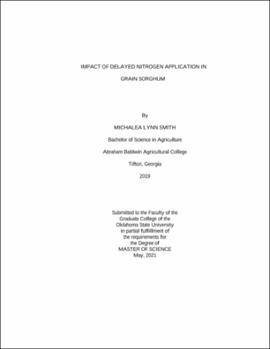| dc.contributor.advisor | Arnall, Brian | |
| dc.contributor.author | Smith, Michaela Lynn | |
| dc.date.accessioned | 2021-09-24T13:58:15Z | |
| dc.date.available | 2021-09-24T13:58:15Z | |
| dc.date.issued | 2021-05 | |
| dc.identifier.uri | https://hdl.handle.net/11244/330949 | |
| dc.description.abstract | A majority of grain sorghum production occurs in the central to north west portion of Oklahoma, where the average annual rainfall is at or below 900 mm and precipitation events become less frequent. The environment conditions associated with this region has resulted in yields being highly variable. This variability makes input management a challenge. One of the primary challenges is N fertilization, not only because it is one of the costliest inputs but determining optimum application rates in these conditions can be challenging. Being able to delay the investments of inputs such as N until crop status and final yield potential is better understood in-season could increase crop NUE. In 2006 Oklahoma State University released a Sensor Based Nitrogen Rate Calculator (SBRNC) for grain sorghum. The SBNRC uses in-season NDVI values from the crop and a N rich strip to predict final grain yield and optimum fertilizer N rate. This technique often requires the crop to experience some degree of N deficiency prior to N to application. The objective of this study is to determine the impact of delaying N application after the onset of N deficiencies and the crops ability to recover. In 2019 growing season this study was conducted at three locations in Oklahoma. Two trials were located at Lake Carl Blackwell Research Farm near Perry OK, and one trail at the Cimarron Valley Research Station near Perkins, OK. Three N rates were applied depending upon the yield potential at each location, LCB1 100 kg ha-1, LCB2 134 kg ha-1, Perkins 90 kg ha-1. In 2020 all locations received 100 kg ha-1 N and included a fourth location on a privately own farm (KMF) near Alva, OK. Using ammonium nitrate as the source of nitrogen, only one treatment received pre-plant N all other treatments except for the un-fertilized check received all N in-season. In 2019 initial side dress application was to begin at first sight of visual difference, a difference between the pre-plant and non-fertilized (check) or 28 days after planting (DAP), while in 2020 first application was moved to 21 DAP. Once side-dressing was initiated one treatment received N every seven days until 70 days after the first application for a total of 10 side-dress application timings. | |
| dc.format | application/pdf | |
| dc.language | en_US | |
| dc.rights | Copyright is held by the author who has granted the Oklahoma State University Library the non-exclusive right to share this material in its institutional repository. Contact Digital Library Services at lib-dls@okstate.edu or 405-744-9161 for the permission policy on the use, reproduction or distribution of this material. | |
| dc.title | Impact of delayed nitrogen application in grain sorghum | |
| dc.contributor.committeeMember | Raun, Bill | |
| dc.contributor.committeeMember | Lofton, Josh | |
| osu.filename | Smith_okstate_0664M_17145.pdf | |
| osu.accesstype | Open Access | |
| dc.type.genre | Thesis | |
| dc.type.material | Text | |
| dc.subject.keywords | delay | |
| dc.subject.keywords | grain sorghum | |
| dc.subject.keywords | nitrogen | |
| dc.subject.keywords | timing | |
| thesis.degree.discipline | Plant and Soil Sciences | |
| thesis.degree.grantor | Oklahoma State University | |
